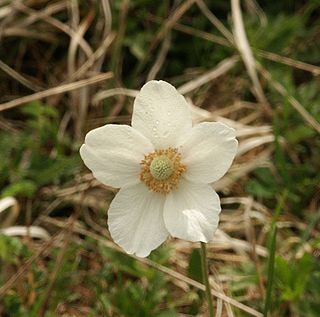
Anemone is a genus of flowering plants in the buttercup family Ranunculaceae. Plants of the genus are commonly called windflowers. They are native to the temperate and subtropical regions of all continents except Australia, New Zealand and Antarctica. The genus is closely related to several other genera including Anemonoides, Anemonastrum, Hepatica, and Pulsatilla. Some botanists include these genera within Anemone.

Anemonoides sylvestris, known as snowdrop anemone or snowdrop windflower, is a perennial plant flowering in spring, native to meadows and dry deciduous woodlands of central and western Europe and temperate Asia. It forms spreading patches, sometimes aggressively spreading.

Glycyrrhiza is a genus of about 20 accepted species in the legume family (Fabaceae), with a subcosmopolitan distribution in Asia, Australia, Europe, and the Americas.

Crambe is a genus of annual and perennial flowering plants in the family Brassicaceae, native to a variety of habitats in Europe, Turkey, southwest and central Asia and eastern Africa. They carry dense racemes of tiny white or yellow flowers on stems above the basal leaves. Crambe hispanica subsp. abyssinica, formerly known as Crambe abyssinica, is grown for the oil from the seeds that has characteristics similar to whale oil.

The genus Pulsatilla contains about 40 species of herbaceous perennial plants native to meadows and prairies of North America, Europe, and Asia. Derived from the Hebrew word for Passover, "pasakh", the common name pasque flower refers to the Easter (Passover) flowering period, in the spring. Common names include pasque flower, wind flower, prairie crocus, Easter flower, and meadow anemone. Several species are valued ornamentals because of their finely-dissected leaves, solitary bell-shaped flowers, and plumed seed heads. The showy part of the flower consists of sepals, not petals.

Malva is a genus of herbaceous annual, biennial, and perennial plants in the family Malvaceae. It is one of several closely related genera in the family to bear the common English name mallow. The genus is widespread throughout the temperate, subtropical and tropical regions of Africa, Asia and Europe.

Inula is a genus of about 80 species of flowering plants in the family Asteraceae, native to Europe, Asia and Africa.

Isatis is a genus of flowering plants in the family Brassicaceae, native to the Mediterranean region east to central Asia. Its genus name, Isatis, derives from the ancient Greek word for the plant, ἰσάτις. The genus includes woad. Due to their extremely variable morphology, the Asian species in particular are difficult to determine; the only reliable diagnostic feature is the ripe fruit. They are (usually) biennial or perennial herbaceous plants, often bluish and hairless or downy hairy with the upright stem branched.

Jacobaea is a genus of flowering plants in the tribe Senecioneae and the family Asteraceae. Its members used to be placed in the genus Senecio, but have been separated into the segregate genus Jacobaea on the basis of molecular phylogenetics in order to maintain genera that are monophyletic.

Rhaponticum is a formerly accepted genus of flowering plants in the tribe Cardueae within the family Asteraceae. As of May 2023, both Plants of the World Online and the Global Compositae Database rejected the genus in favour of Leuzea. Plants of the World Online placed all its species in that genus, apart from one unplaced species, Rhaponticum scariosum.
Leuzea is a genus of flowering plant in the family Asteraceae. Its species are native to Macaronesia, North Africa, and eastwards throughout temperate Eurasia. The genus was established by Augustin Pyramus de Candolle in 1805.

Seseli is a genus of herbaceous perennial plants in the family Apiaceae. They are sometimes woody at base with a conic taproot. Leaf blades are 1–3-pinnate or pinnately decompound. Umbels are compound, with bracts few or absent. Petals are white or yellow, and the fruit ovoid or ellipsoid.

Micranthes is a genus of flowering plants in the saxifrage family. It was formerly included within the genus Saxifraga until recent DNA evidence showed the members of what is now Micranthes are more closely related to Boykinia and Heuchera than to other members of the genus Saxifraga.

Dichoropetalum is a genus of flowering plants in the carrot family.

Anemonastrum is a genus of flowering plants in the family Ranunculaceae. Plants of the genus are native to the temperate and subarctic regions of North America, Greenland, Europe, Asia, South America, and New Zealand. The generic name Anemonastrum means "somewhat like anemone", a reference to the Anemone genus of closely related plants. It chiefly differs from Anemone in having a base chromosome number of x=7, as opposed to x=8.

Oreomecon is a genus in the poppy family Papaveraceae. It was established in 2022 for what was previously treated as Papaver sect. Meconella in order to ensure that the genus Papaver was monophyletic. As of June 2023, names in the genus Oreomecon had only been published for better known and phylogenetically understood species present in Europe, either as natives or aliens.















